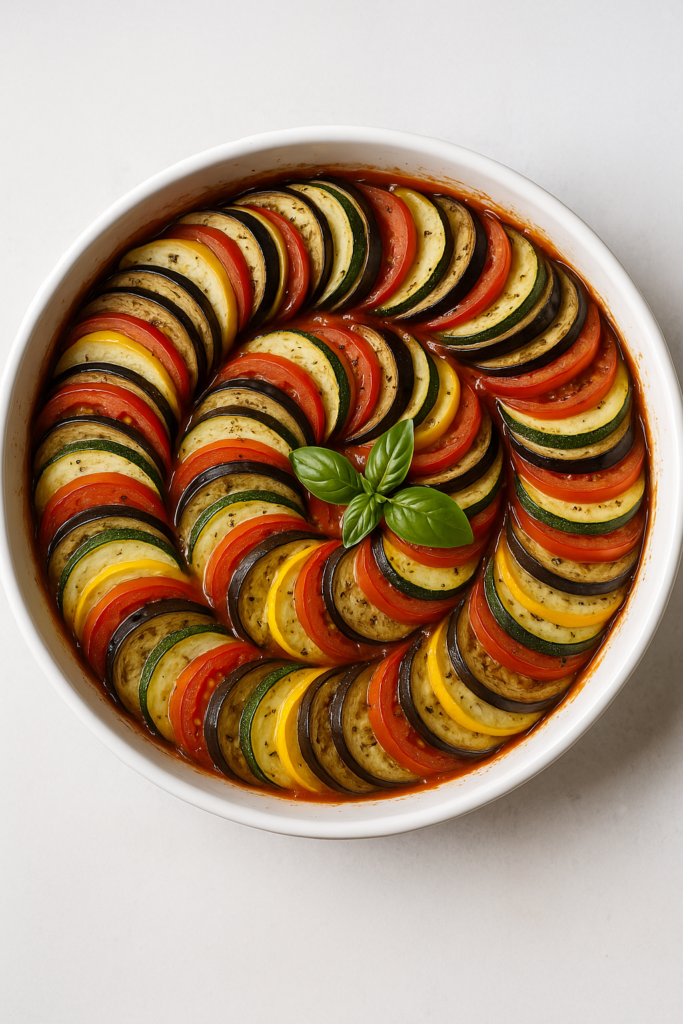
French food is often described as elegant, romantic, and timeless—and for good reason.
Rooted in centuries of culinary tradition, French cuisine is a rich tapestry of flavor, artistry, and cultural pride.
From delicate pastries to slow-cooked stews, French food has a magical way of transforming everyday ingredients into unforgettable experiences.
But among the foie gras, escargot, and crème brûlée, there’s one dish that stands out not for its extravagance, but for its heartwarming simplicity: ratatouille.
Ratatouille is a classic Provençal dish that represents the very soul of southern French food. With vibrant layers of fresh vegetables, aromatic herbs, and olive oil, it’s a dish that tells the story of the sun-soaked fields and coastal kitchens of the French Riviera.
It’s humble, wholesome, and deeply flavorful—everything that makes French food so beloved around the world.
More than just a recipe, ratatouille is a culinary journey. It’s a dish steeped in tradition, yet endlessly adaptable.
It’s comfort food that feels elevated, rustic but refined.
And thanks to its starring role in pop culture, it’s also become one of the most recognizable and approachable French recipes for home cooks everywhere.
In this blog post, we’re diving deep into the world of ratatouille—exploring its origins, why it’s such an enduring favorite in the realm of French food, and how you can recreate it in your own kitchen (with no passport required).
Whether you’re a seasoned cook or a first-time food explorer, this guide will help you fall in love with one of France’s most iconic and soul-satisfying dishes.
🇫🇷 What Is Ratatouille?
Ratatouille is a vibrant, vegetable-based dish that’s become one of the most iconic staples of French food.
At its core, ratatouille is a celebration of seasonal vegetables, gently cooked to bring out their natural sweetness and layered to perfection.
Traditional recipes include eggplant, zucchini, bell peppers, tomatoes, onions, garlic, and fresh herbs—each ingredient playing a key role in delivering the complex yet comforting flavor that French cuisine is known for.
What makes this dish stand out among other French food options is its flexibility. Ratatouille can be served hot, cold, or at room temperature.
It’s enjoyed as a hearty main course, a savory side dish, or even as a topping for crusty bread or pasta.
Its simplicity is deceiving—every bite bursts with the taste of Provence, making it the perfect introduction to anyone discovering French food for the first time.
🥖 A Slice of French Food History
To truly appreciate ratatouille, it helps to understand its roots in the history of French food.
The dish originated in the Provence region of southeastern France, where sun-ripened vegetables grow in abundance.
The name “ratatouille” is believed to come from the French verb touiller, which means “to stir up”—a nod to the traditional method of slowly cooking and blending vegetables together in a single pot.
Originally, ratatouille was considered peasant food.
Farmers and rural families would prepare it as a way to use up leftover vegetables from the garden—a no-waste, all-flavor approach that embodies the spirit of rustic French food.
Over time, chefs across France began refining the dish, adding technique and flair while preserving its humble charm.
Today, you’ll find ratatouille on the menus of both casual French cafés and Michelin-starred restaurants, proving that some of the best French food comes from the simplest origins.
🌍 Why Foodies Travel for This French Food Favorite
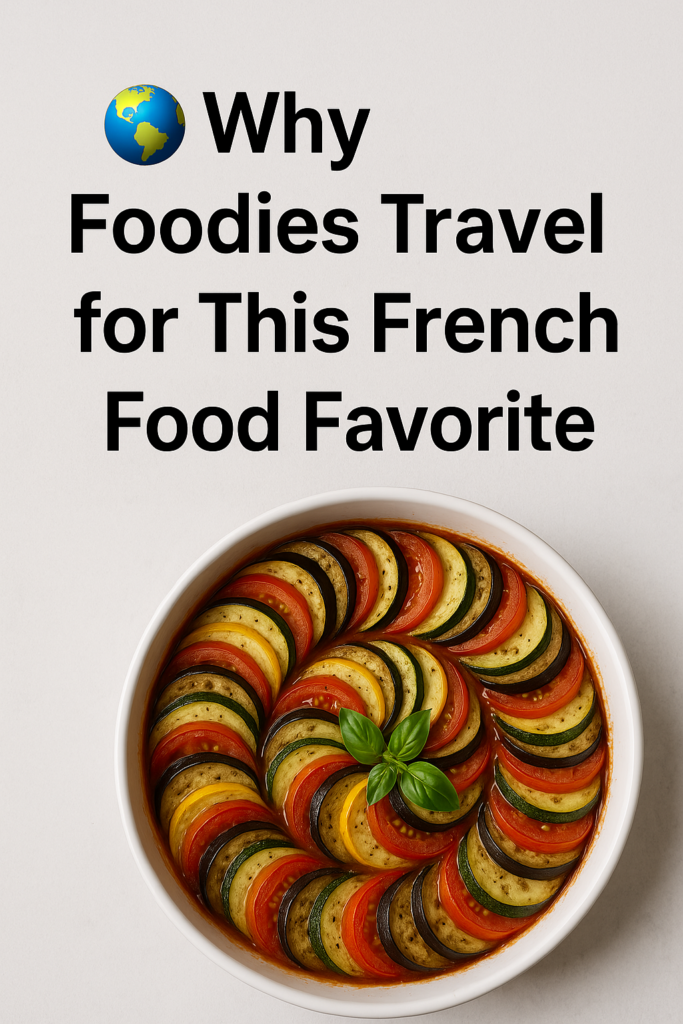
When food lovers dream of visiting France, they often imagine pastries in Paris or cheese in the Alps—but true culinary explorers know that French food offers far more, especially in regions like Provence.
Ratatouille, with its stunning presentation and deep flavors, has become a must-try dish for anyone looking to experience authentic regional cuisine.
Travelers flock to French food markets and countryside kitchens to taste ratatouille made the traditional way—using sun-kissed vegetables, extra virgin olive oil, and herbs freshly picked from the garden.
The dish perfectly represents the Mediterranean lifestyle: simple, nourishing, and deeply connected to nature.
Moreover, ratatouille has gained international recognition not just because it’s delicious, but because it represents the heart of French food culture.
It’s vegetarian, naturally gluten-free, and packed with vitamins and antioxidants, making it appealing to modern travelers who crave both authenticity and wellness.
Whether you’re exploring a local eatery in Nice or taking a French cooking class in Lyon, tasting ratatouille is like tasting the soul of France.
🍲 How to Make Ratatouille at Home
One of the most beautiful things about French food is that it invites you to slow down, enjoy the process, and cook with intention—and ratatouille is no exception.
While it may look intricate with its beautifully arranged layers and rich aromas, making ratatouille at home is surprisingly approachable.
With just a few simple ingredients and some patience, you can recreate this beloved French dish in your own kitchen, no passport required.
There are two common ways to prepare ratatouille: the traditional rustic method, where vegetables are sautéed together in a pan for a more stewed texture, or the confit byaldi method, popularized by the movie Ratatouille, where vegetables are sliced thinly and layered into a circular, oven-baked pattern.
Both are equally delicious and reflect the thoughtful craftsmanship that defines French food.
Here’s a classic oven-baked version that combines both beauty and flavor:
📝 Ingredients:
- 1 medium eggplant, thinly sliced
- 1 zucchini, thinly sliced
- 1 yellow squash, thinly sliced
- 1 red bell pepper, thinly sliced
- 1 yellow bell pepper, thinly sliced
- 3 ripe tomatoes, thinly sliced or chopped
- 1 small onion, diced
- 3 cloves garlic, minced
- 2 tablespoons olive oil
- 1 tablespoon tomato paste (optional)
- 1 teaspoon herbs de Provence
- Salt and black pepper to taste
- Fresh basil for garnish
🍳 Instructions:
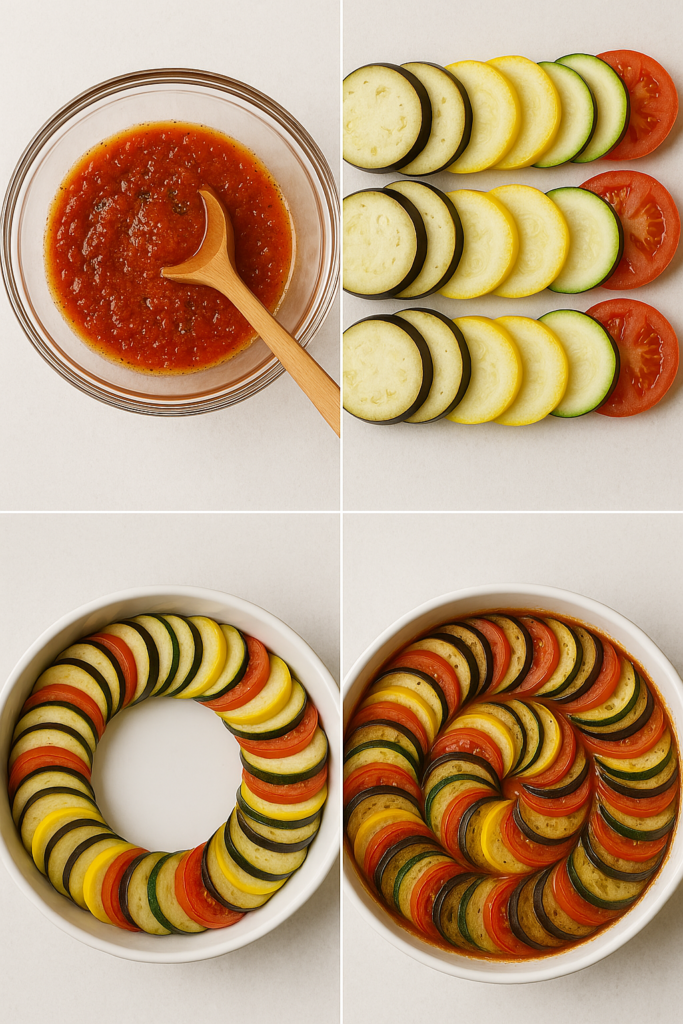
- Preheat oven to 375°F (190°C).
- In a pan, sauté diced onion and garlic in olive oil until soft and fragrant. Add tomato paste and chopped tomatoes. Simmer for 5–7 minutes to create a base sauce.
- Spread the sauce into the bottom of a baking dish.
- Arrange the sliced vegetables over the sauce in an alternating, overlapping spiral or row pattern.
- Drizzle the top with olive oil and sprinkle with herbs de Provence, salt, and pepper.
- Cover the dish with foil and bake for 40–45 minutes, or until vegetables are tender.
- Remove foil and bake uncovered for an additional 10 minutes to let the top caramelize slightly.
- Garnish with fresh basil and serve warm or at room temperature.
Serve your homemade ratatouille as a main dish with crusty bread, over rice, or as a side to grilled meat or fish.
It’s a fresh, flavorful, and visually stunning example of how French food combines elegance with rustic charm.
💡 Pro Tip: Make It Your Own
One of the things that makes French food so inviting is its flexibility—traditional, yes, but never rigid.
Ratatouille, like many other classic dishes, lends itself to personal flair without losing its soul.
If you’re new to French cooking or simply love to experiment, ratatouille is the perfect dish to play with.
Want more depth and richness?
Add a splash of red wine to your tomato base. Looking for extra texture? Try roasting your vegetables slightly before layering them.
Craving some protein?
Top your finished ratatouille with a poached egg, grilled chicken, or crumbled goat cheese.
You can even bake it in individual ramekins for elegant, dinner-party-worthy servings.
For a modern twist, try serving ratatouille cold as a summer salad, or turn it into a savory galette (a rustic tart) with puff pastry.
No matter how you serve it, ratatouille remains a shining star in the world of French food—a dish that evolves with every cook, every kitchen, and every craving.
🧑🍳 Ratatouille for Different Diets: Why It’s a French Food Everyone Can Enjoy
One of the biggest reasons ratatouille continues to trend in modern kitchens is its diet-friendly versatility.
This classic French food checks so many boxes—it’s vegetarian, gluten-free, dairy-free, and even vegan.
Whether you’re following a Mediterranean diet, eating clean, or simply looking for a light, nutrient-packed meal, ratatouille delivers.
You can even make it keto-friendly by reducing tomatoes or serving it over cauliflower rice.
And for those counting macros or watching sodium, it’s incredibly easy to control seasoning and ingredient ratios.
French food isn’t always known for being “light,” but ratatouille breaks that mold beautifully.
🍷 Perfect Pairings: What to Serve with Ratatouille
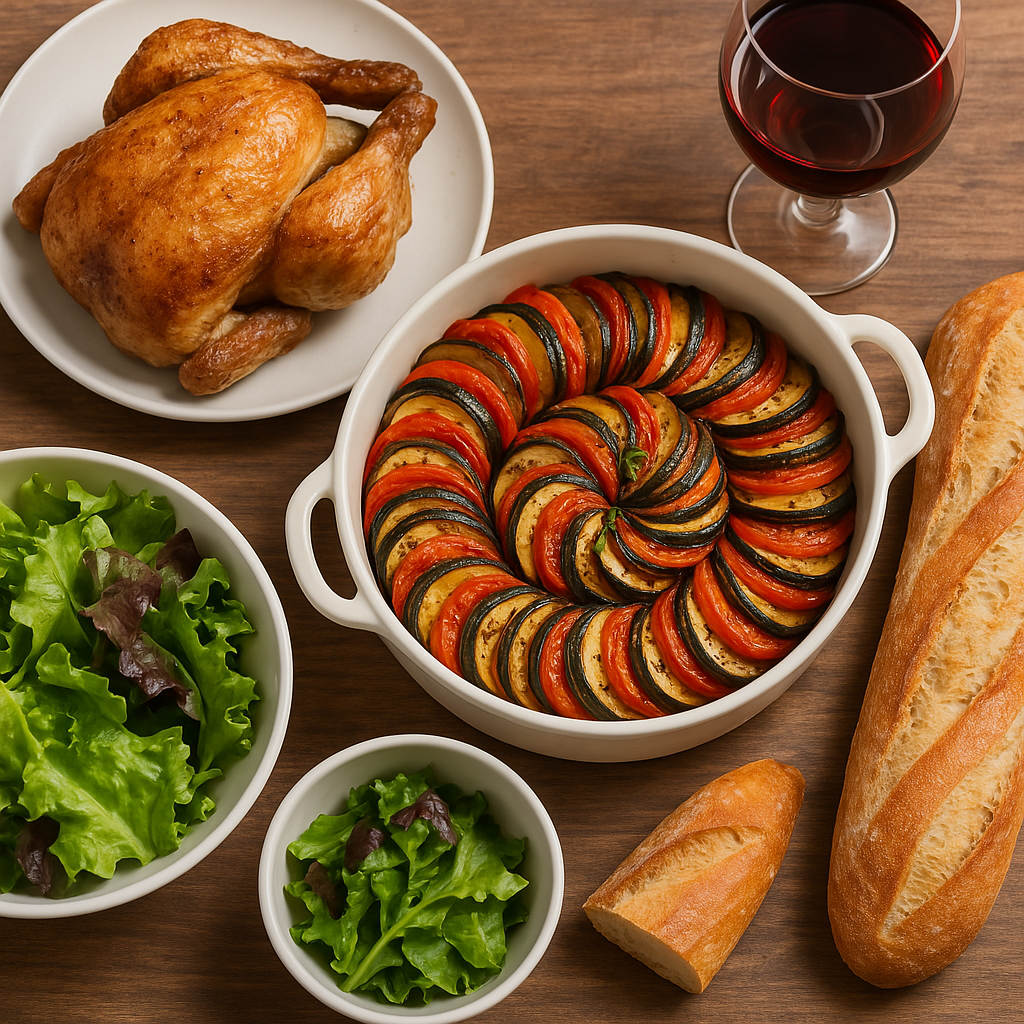
Although ratatouille shines on its own, pairing it with complementary dishes can elevate your French dining experience.
For a full French food spread, serve ratatouille alongside a crusty baguette or a simple herbed rice pilaf.
Add a crisp green salad with a Dijon vinaigrette to balance the richness of the stew.
Want to turn it into a fancy dinner party entrée? Pair it with grilled fish like trout or a simple roast chicken.
And don’t forget the wine—a dry rosé or light red like Pinot Noir pairs beautifully with the bright, herbaceous flavors of the dish.
The beauty of French food lies in how harmoniously dishes come together—and ratatouille is a perfect base for building a thoughtful, delicious meal.
🎬 Pop Culture Spotlight: How Ratatouille Became a Global Star
Many people outside of France were introduced to ratatouille through the 2007 Pixar film Ratatouille.
The movie didn’t just make this classic French food a household name—it gave it a new life, especially among younger audiences and aspiring home chefs.
Suddenly, ratatouille wasn’t just a French dish—it was a story about passion, creativity, and believing that anyone can cook.
This pop culture moment helped spark a global interest in traditional French food and inspired millions to recreate the animated dish in real life.
Today, food bloggers, chefs, and YouTubers continue to reinterpret ratatouille in colorful, layered forms, proving that a simple Provençal stew can steal the show—on screen and on the table.
📸 Ratatouille Is Instagram-Worthy: Tips for Styling and Photographing This French Food Favorite
Ratatouille is one of the most photogenic French food dishes you can make.
Its colorful medley of sliced vegetables, artfully arranged in spirals or rows, is a food stylist’s dream—and perfect for social media sharing.
To capture that “wow” moment:
- Use a round or oval baking dish for visual flow.
- Arrange your vegetables in alternating colors for contrast.
- Brush the top with olive oil before baking to get a glistening finish.
- Snap your photos in natural light, from above or at a 45° angle.
- Garnish with fresh herbs right before serving for a pop of green.
Whether you’re a food blogger or just love sharing your culinary wins online, ratatouille is one French food you’ll be proud to show off.
📦 Make-Ahead & Storage Tips: French Food That Lasts
One of the many reasons ratatouille stands out in the world of French food is its ability to taste even better the next day.
Like many stews, the flavors continue to develop as the ingredients rest, making it an ideal make-ahead dish for busy weekdays or meal prep.
💡 Storage Tips:
- Refrigerator: Store in an airtight container for up to 4–5 days.
- Freezer: Freeze in portioned containers for up to 2 months. Thaw in the fridge overnight before reheating.
- Reheating: Gently reheat on the stove or in the microwave. Add a drizzle of olive oil to refresh the flavor.
This makes ratatouille not only a beloved dish in French food culture, but also a practical one for home cooks who love meals that are beautiful, healthy, and convenient.
🧭 French Food Travel Tip: Where to Eat Ratatouille in France
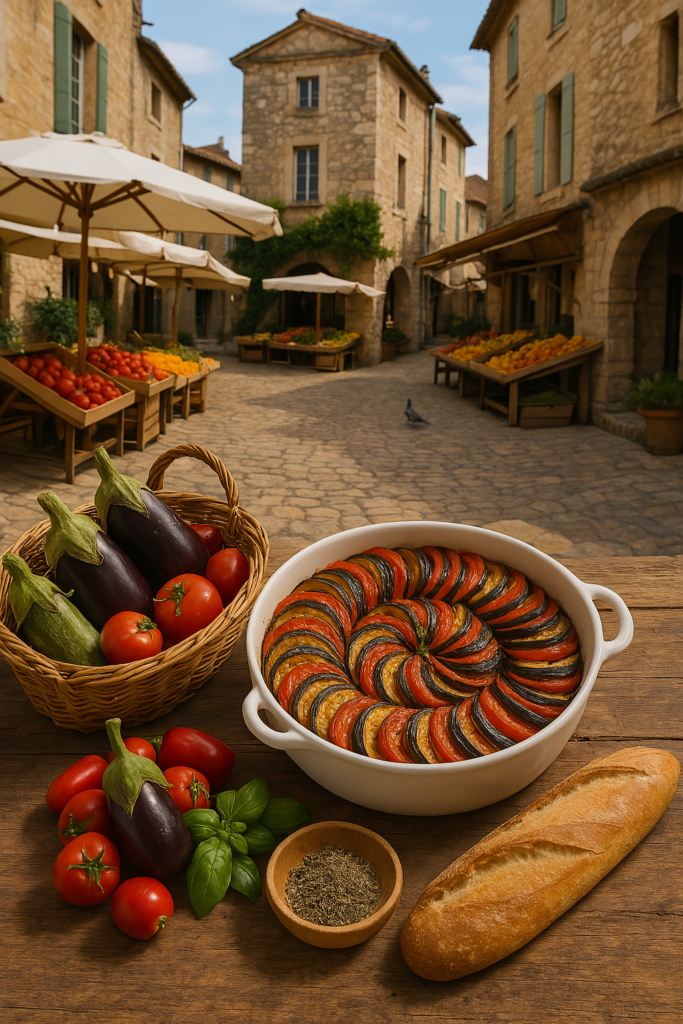
If you’re planning a food-focused trip to France, ratatouille is a must-try dish best experienced in its place of origin—Provence.
Known for its lavender fields, sun-soaked markets, and laid-back charm, Provence offers the perfect setting to enjoy this vegetable-forward masterpiece.
Look for traditional French food restaurants, known as bistros or auberges, especially in towns like Avignon, Aix-en-Provence, or Nice.
For a truly authentic experience, visit local farmers markets and try a homemade version from a vendor or café.
Many even serve it with warm socca (a chickpea flour pancake) for a local twist.
Tasting ratatouille in its homeland will give you a whole new appreciation for its simplicity and elegance—and remind you why French food continues to inspire chefs and home cooks worldwide.
🍽️ Serving Ratatouille Around the World: A Global Twist on French Food
While ratatouille is rooted in the traditions of Provence, this classic French food has found its way onto plates around the globe—with creative twists in every corner.
Chefs and home cooks alike are embracing the dish and giving it new life by fusing it with local flavors.
In Italy, you might find ratatouille topped with parmesan and served over creamy polenta.
In North Africa, it’s often spiced with cumin and coriander and paired with couscous.
Even in the U.S., ratatouille-inspired casseroles are trending, where the layered vegetables are baked with cheese and breadcrumbs for a comforting spin.
What’s beautiful about French food is that while it’s deeply traditional, it invites creativity and adaptation.
Ratatouille, with its universal appeal and flexible ingredients, is the perfect example of how a humble French dish can become a global favorite—while still honoring its roots.
📚 Ratatouille in French Food Literature & Culinary Schools
Ratatouille isn’t just a dish—it’s studied, taught, and celebrated in culinary schools and food literature around the world.
Many renowned French chefs, including Julia Child and Jacques Pépin, have shared their own variations of ratatouille, highlighting the technique and timing required to perfect this classic French food.
It’s also a staple in culinary education because it teaches essential skills: knife work, layering flavors, and cooking with seasonal produce.
Whether you’re reading a French cookbook or watching a cooking show, you’ll likely come across a ratatouille tutorial—it’s one of those dishes that everyone respects in the culinary world.
For food lovers and aspiring chefs, learning to make ratatouille is a rite of passage in exploring French food.
It’s approachable yet elegant, structured yet flexible—a dish that embodies everything French cuisine stands for.
🥂 A Timeless Taste of French Food at Home
Ratatouille is more than just a colorful vegetable dish—it’s a story told through layers of flavor, culture, and tradition.
It represents everything we love about French food: simplicity with elegance, rustic charm with refined technique, and ingredients that honor the seasons.
Whether you’re savoring it on a terrace in Provence or enjoying your own homemade version in the comfort of your kitchen, ratatouille invites you to slow down and experience the heart of French cuisine.
It’s proof that a few humble vegetables, when cooked with care, can become something extraordinary.
So, whether you’re a curious beginner, a passionate foodie, or a seasoned traveler dreaming of your next culinary escape—ratatouille deserves a spot on your table.
It’s comforting, beautiful, and packed with flavor—and most importantly, it’s a celebration of how French food can turn the simplest ingredients into unforgettable meals.
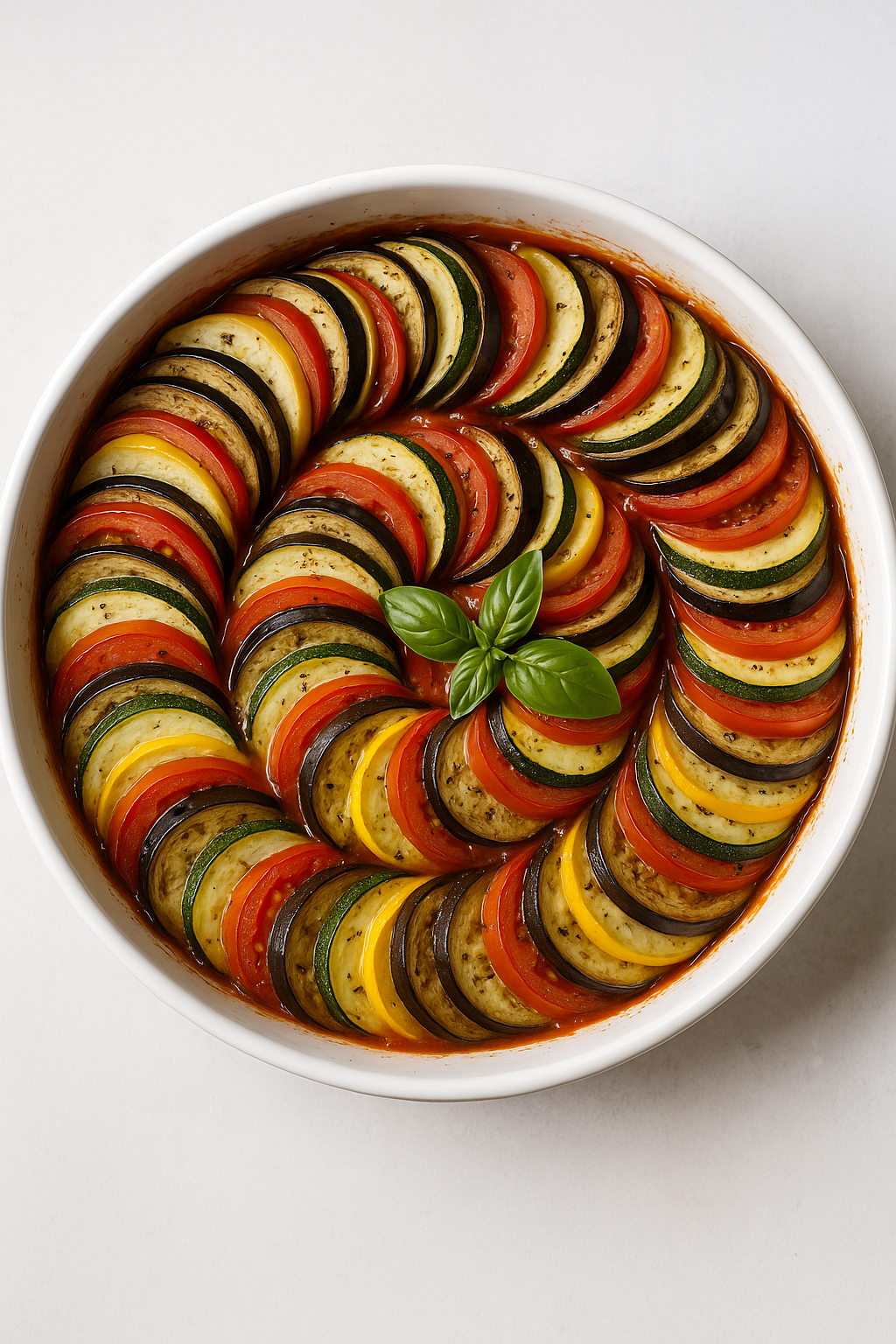
Classic French Ratatouille
Ingredients
Equipment
Method
- In a skillet, heat olive oil over medium heat. Add diced onion and sauté until soft. Stir in garlic, then add chopped tomatoes and tomato paste. Simmer for 5–7 minutes. Season with salt, pepper, and herbs de Provence.
- Set your oven to 375°F (190°C).
- Spread the tomato base evenly in the bottom of a round baking dish. Arrange the sliced vegetables in a circular pattern, alternating colors (eggplant, zucchini, squash, tomato).
- Drizzle olive oil over the vegetables, then sprinkle with salt, pepper, and additional herbs de Provence if desired. Cover with foil and bake for 40–45 minutes. Uncover and bake for another 10 minutes until lightly browned.
- Remove from the oven, let rest slightly, and garnish with fresh basil. Serve warm with crusty bread or as a side dish.
- Calories: 180
- Fat: 10g
- Carbohydrates: 20g
- Protein: 3g
- Fiber: 6g
- Sugar: 10g
Notes
Slice vegetables uniformly for even cooking and visual appeal. You can use canned crushed tomatoes instead of fresh for convenience. Leftovers keep well for 4–5 days in the fridge and taste even better the next day. Great served with rice, couscous, or roasted chicken. To freeze, let cool completely and store in airtight containers for up to 2 months.
📣 Ready to Bring a Bit of France Into Your Kitchen?
✨ Try this ratatouille recipe today, and share your creation with us on Pinterest
📌 Don’t forget to save this post for later and explore more French food favorites on our blog.
💬 Have a favorite twist on ratatouille? Drop your tips or variations in the comments—we’d love to hear how you make this classic your own!
Bon appétit! 🇫🇷❤️
Other Must Try Recipes:
Make the Best Tzatziki Ever: A Must-Try from Classic Greek Recipes 🏛️
As an Amazon Associate, I earn from qualifying purchases.


